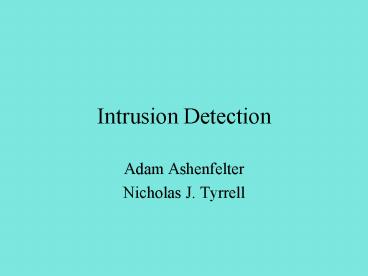Intrusion Detection PowerPoint PPT Presentation
1 / 16
Title: Intrusion Detection
1
Intrusion Detection
- Adam Ashenfelter
- Nicholas J. Tyrrell
2
What Is Intrusion Detection
- A network burglar alarm
- Passively monitors the system for suspect
behavior - Sources for monitored data
- Audit trails (logs of user commands)
- System calls
- Network traffic
3
Examples of Suspect Behavior
- System use outside of normal time
- Abnormal frequency of use
- Abnormal volume of data referenced
- Abnormal patterns of reference to programs or data
4
Some Possible Intrusions
- External Penetrator
- An attacker who has gained access to a computer
of which he is not a legitimate user - Masquerader
- An attacker who has gained the gained access to a
valid users account - Misfeasor
- A legitimate user who abuses his privileges to
violate system security policies
5
Types of Intrusion Detection
- Policy based detection
- Detects using a predefined rule base
- Anomaly detection
- Collects statistics, generating profiles for
normal/abnormal behavior
6
Policy Based Detection
- Pros
- Good against known attacks
- False alarms can be kept low
- Normally less computationally expensive
- Cons
- Very susceptible to novel or unusual attacks
- Writing the rules can be very tedious
- If the rules become known to an attacker, they
can be avoided
7
Anomaly Detection
- Pros
- Robust against new types of attacks
- Can learn by example, no need to write rules by
hand
- Cons
- Might give false alarms for unusual but valid
behavior - Computationally expensive sometimes requiring
off-line algorithms - Might learn to accept dangerous behavior as
normal over time
8
Some Current and Previous Intrusion Detection
Systems
- NIDES
- NADIR
- NSM
9
NIDES
- Evolved from IDES over the early 1990s
- Uses both rule based and anomaly detection
10
NIDES
- Pros
- Highly Modularized
- Real or non-real time detection
- Low false positive rate (false alarms)
- Cons
- Susceptible to Tampering
- Direct attack on Nides
- Reverse Engineering
- Attacker could avoid rules used by Nides policy
detection
11
NADIR
- Automated system for detecting network intrusion
and misuse - Developed at Los Alamos National Laboratory
- Served 9000 computers including 6 Cray-class
computers - Uses rules at system wide level and also creates
statistical profiles for each user
12
NADIR Continued
- Pros
- Highly Interactive
- Error Detection
- System Management
- User Education
- Cons
- High number of false positives
- Needs better anomaly detection
- Not real time detection
13
NSM
- Prototype deployed at UC Davis during 1980s
- First System to use Network data directly
- Layered approach to data collection
- Uses both policy and anomaly detection
14
NSM Continued
- Pros
- Audit data instantly available
- Impervious to direct attack
- Low impact on system resources
- Cons
- Attacks made on hosts without accessing the
network are undetectable - Cryptography could be the death of NSM
15
Some Current Research Areas
- Data Mining
- Using data mining techniques to better find
consistent and useful patterns from logged data
to use as rules - Machine Learning
- Using machine learning methods, such as neural
networks, to try and build better anomaly
detection (fewer false alarms)
16
Biliography
- Axelsson, S. (1999) Research in
Intrusion-Detection Systems A Survey - Ghosh, A. Schwartzbard, A., Schatz, M. Learning
Program Behavior Profiles for Intrusion Dection - Ryan, J., Lin, M., Miikkulainen, R. (1998)
Intrusion Detection with Neural Networks In
Advances in Neural Information Processing Systems
10 - Lane, T., Brodley, C (1997). An Application of
Machine Learning to Anomaly Detection - Lee, W., Stolfo, S. Data Mining Approaches for
Intrusion Detection

